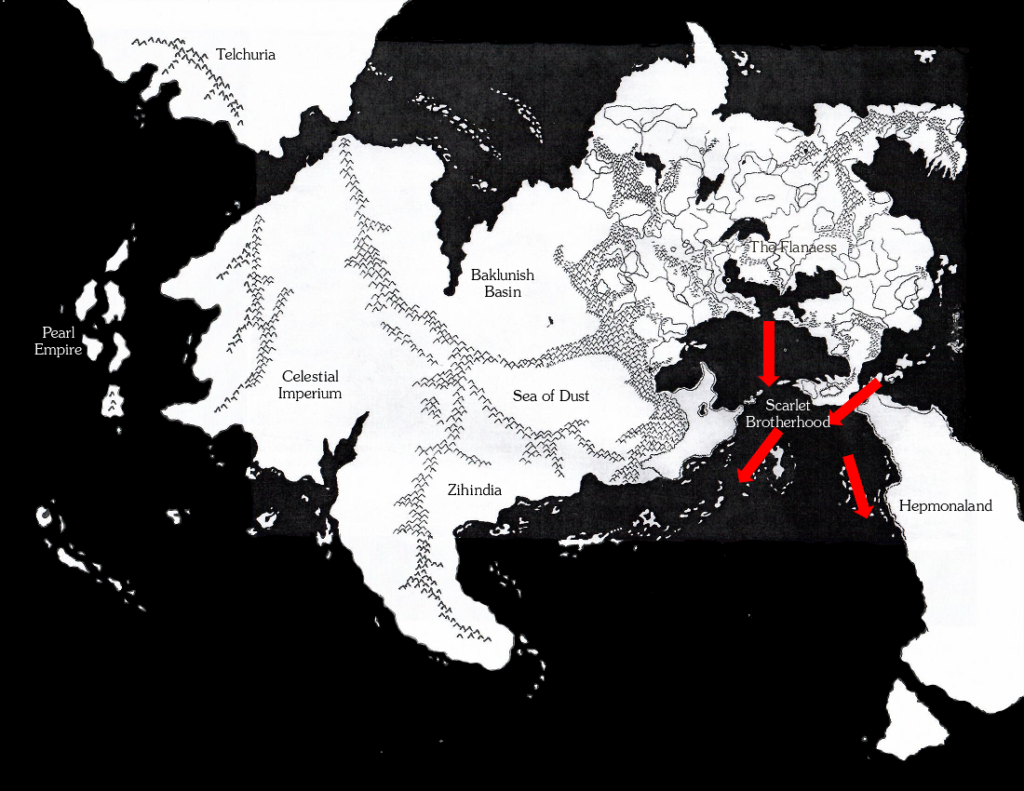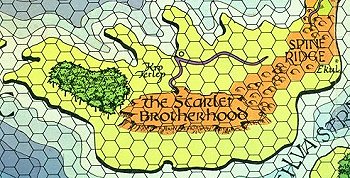One thing I noticed when contemplating the map of Oerik from the folio (and my own version thereof) is that the Scarlet Brotherhood could not have picked a better spot, in a strategic sense, to cut off the Flanaess from outside influence and trade.
Historically, medieval Europe traded with cultures as far distant as India, China, Japan, and sub-Saharan Africa. Spices and silks from Asia, cloth from Egypt, and other goods of all sorts could be found throughout Europe. In large part, this was aided by geography; there were relatively open borders eastward and southward, and ships could travel the Mediterranean to pick up items which had been shipped across the Indian Ocean, or overland through Asia.
The Flanaess, on the other hand, is in a very different position geographically. To the west there is a solid line of mostly impenetrable mountain ranges, with only a small gap in Ket/Bissel, and some passes leading from Ket to Perrenland. To be sure, there is some trade through Ket, but it is but a trickle compared to the reality of Europe.
And to the south? Now things become more interesting.
Ordinarily one would expect a huge amount of sea trade through the Densac Gulf, heading to Zihindia, Hepmonaland’s west coast, and beyond. But we never hear of such trade in any of the sources. In the thronging markets of Greyhawk there are no spices from Zihindia or silks from the far-off Celestial Imperium. Why is this? I suspect it has something to do with the grand design of the Scarlet Brotherhood, and its strategic location.

In order to reach anywhere westward by ship, one has to pass by the Scarlet Brotherhood. Both the Densac Gulf, which connects the Azure Sea with the rest of the world’s oceans, and the Tilva Strait, which connects the Oljatt Sea with all points westward, are directly adjacent to the lands controlled by the Brotherhood of the Scarlet Sign.
While nothing has been made of this in the canon sources of which I’m aware, I speculate that the lack of robust trade through the Densac Gulf is due to the machinations of the Brotherhood. With such proximity to these strategic waters, they would be in a perfect position to cut off or discourage trade if they desired. Pirates and raiders could find safe harbors on the peninsula, providing both revenue and strategic advantage to the Brotherhood.
The question remains, however, why the Brotherhood would want to do this? Why cut off the Flanaess from trade with other lands?
I suspect the answer lies in their ideology of Suloise purity and supremacy. Dealing with Oeridian, Baklunish, and Flannae influences among the Suel population of the Flanaess would be bad enough, but the corruptive influences of Zihindia and the Celestial Imperium would be yet more impurities to have to erase, especially if the means to cut off such influence were easily at hand.










I am digging that Flanaess map so much. You are right though, trade should be wide open, so it has to be controlled. We DO know the Scarlet Brotherhood has their tendrils all the over the tropics. If not them, the Lordship of the Isles and the Sea Princes do, and we know how they turned out.
IMC, the “thief” arm of the Scarlet Brotherhood triumvirate IS pirates. This gives them a reason to be on the seas enriching themselves without being outed.
If you study the map, you wonder why a ship has never rounded the Amedio Coast to Sunela, a Suel land unscathed by the Rain of Colorless Fire, which is actually a short distance by ship.
The Scarlet Brotherhood could easily blockade the Azure Sea the same way Carthage blocked the way to the Atlantic from Roman access until Rome removed them from the playing field.
Sunela is actually a fan creation, and is located where Zihindia is on my map (Zindia on the DA#1 map).
I actually also postulate a connection between the destruction of the Suel Imperium and Zihindia, though. More to come on that…
Actually, we can simply speculate that the Brotherhood behaves like Venice at one time did: it simply makes ships from outside the Flanaess make port at their own cities, and re-exports the goods to the Flanaess, making itself the monopolistic commercial power. Also, the same could apply to the Sea princes, who might be the other maritime power controlling entry of goods from outside the Flanaeess, especiallif we postulate a string of ports/fortresses southward on the Amedio Jungle.
I think there is reasonable trade with other realms beyond the Flanaess, but that it is tightly controlled by the Brotherhood and the Sea Princes.
I always thought the Flanaess was generally cut off from the rest of the world for the exact reasons Mr. Bloch mentions even without the Scarlet Brotherhood’s interference.
I’m not as sure the Brotherhood would simply cut off those sea routes, though, not when as Mike Bridges suggested they could use pirates to loot any traders coming up through those areas. And since so many of the jungle peoples are Suel, the Brotherhood could just as easily trade with them itself, along with helping them against the Olman and other peoples in the area.
IIRC, Dwellers Of The Forbidden City also implied that there’s semi-regular trade between the eastern lands of the Flanaess and the peoples of Hepmonaland. With the Brotherhood’s takeover of the Lordship of the Isles and the Sea Princes, they could take advantage of any contacts those realms have made with the jungle Suel. That’d be another avenue to profit from southern trade and help their jungle kin against the hated Olman.